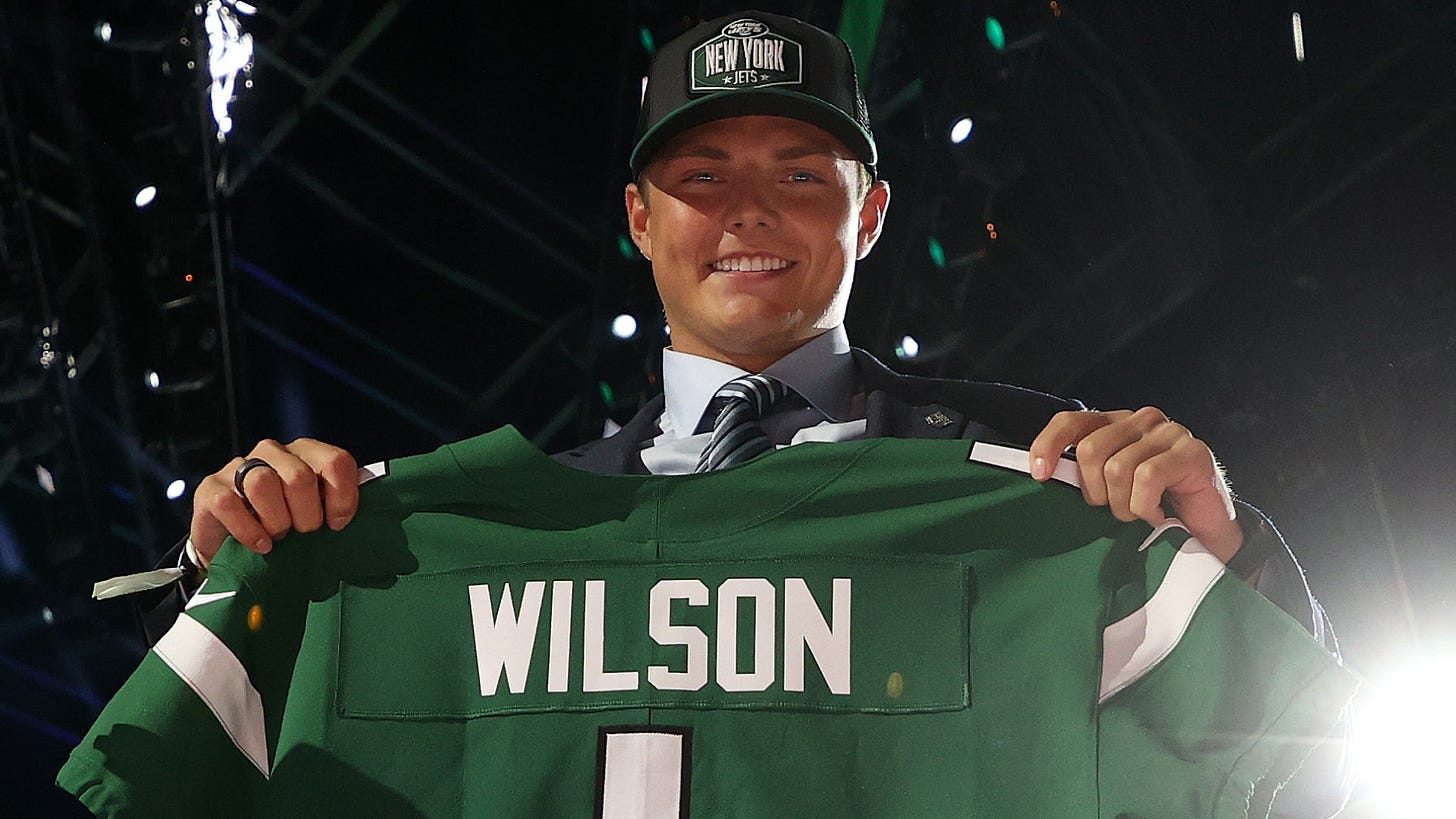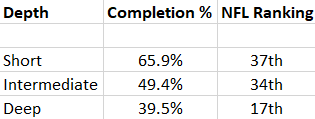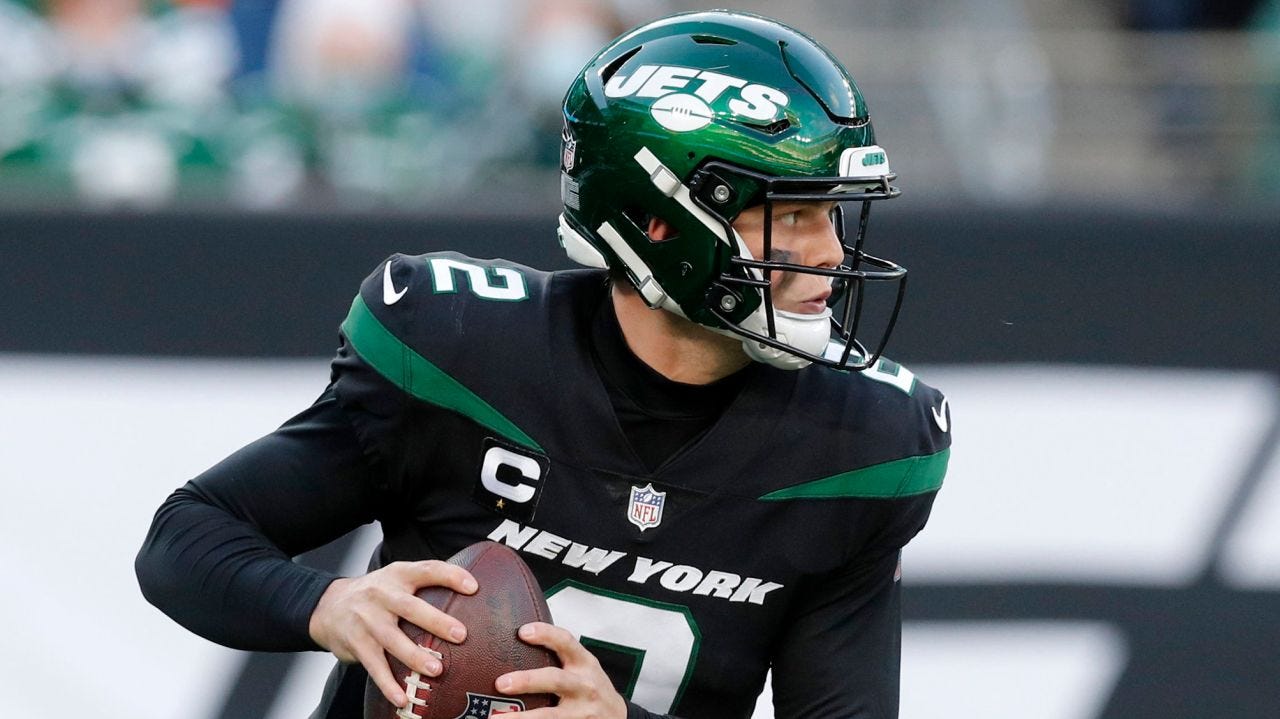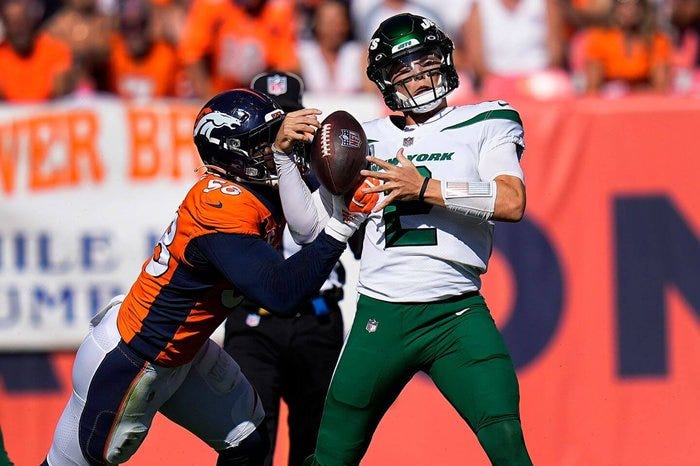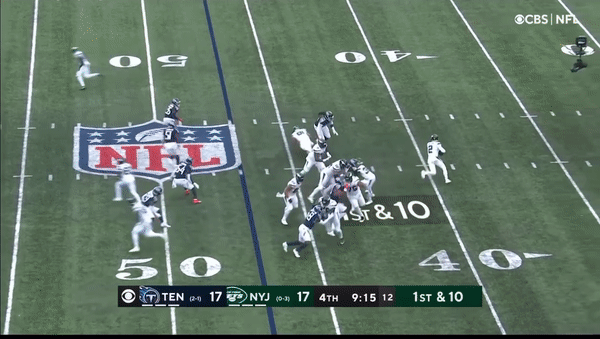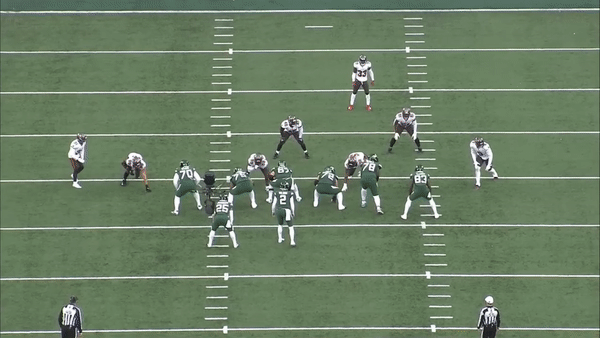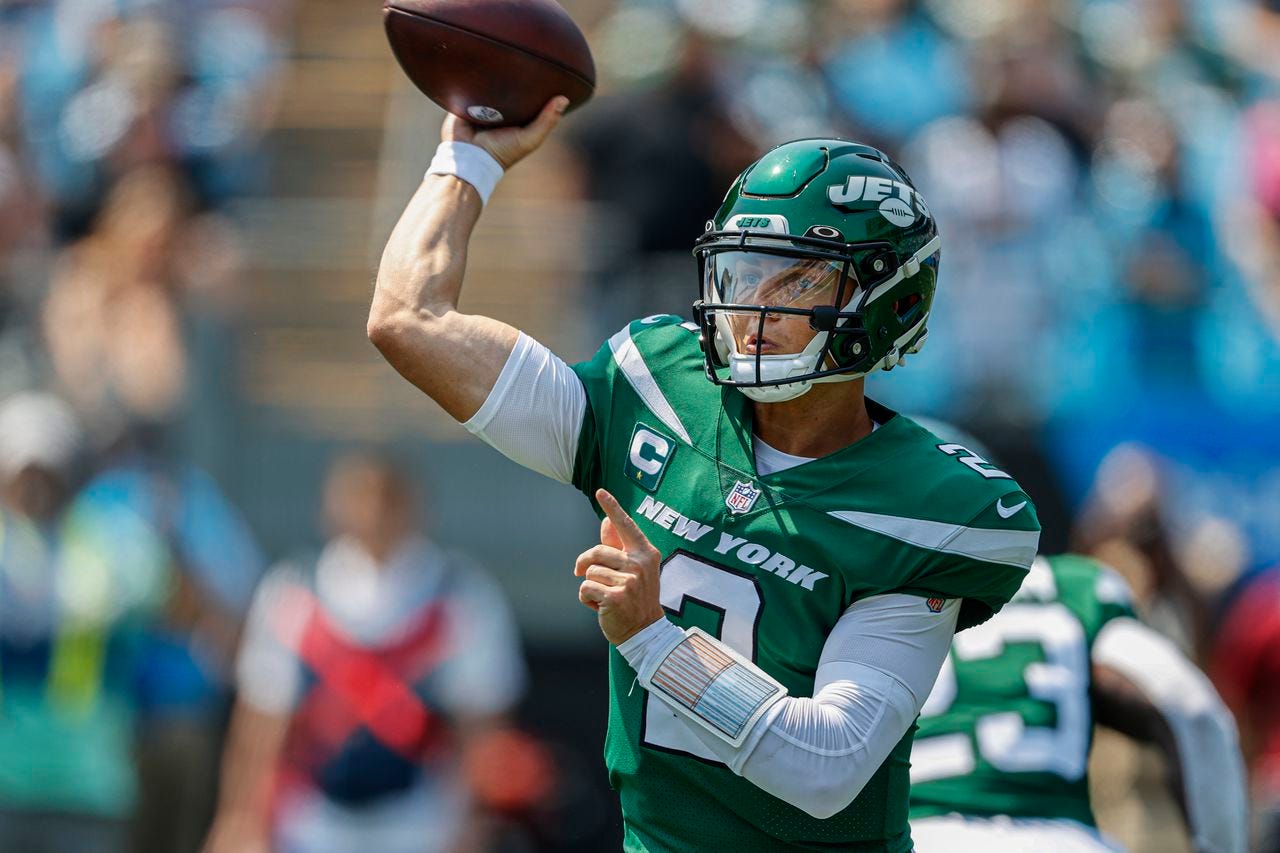🗽 Good morning Jets fans and welcome to the first-ever out-of-season TJW newsletter. When the season comes to a close I usually like to take a little break from the Jets, focus on the New York Knicks 🏀 and New York Rangers 🏒 before circling back around to the Jets a few weeks before free agency begins. However, TJW means I’m going straight into review mode, starting with Zach Wilson.
Optics
Taking a look at the key statistics from 2021, it doesn’t look great for Zach Wilson. The 55.6% completion percentage was good for worst in the league behind fellow rookies Justin Fields and Trevor Lawrence. His touchdown percentage was good for 29th, his QB rating of 69.7 was the worst mark in the league and his 28.5 QBR was 31st.
When using pure statistics, it’s hard to argue against the fact that Zach Wilson had a poor season, even for a rookie. But yet, if you watched every game you’d notice that his season really was a season of two halves. You had the first 6 games before the injury and then the 7 games post-injury.
Hero Ball
Over the first six games of the season, there was evidence of naivety in Zach Wilson’s play. He often tried to extend drives by playing what we like to call hero-ball, he could do it at BYU, so why not the NFL? After all, what he did at BYU got him drafted, what he did at BYU enamored the Jets to an extent that reports suggested the team quickly zeroed in on the Cougar, a sort of “Vontae Mack. No matter what” type moment.
He soon found out that putting 400 yards and 4 touchdowns on Houston is a little different to facing the Patriots and Bill Belichick. His 4 INT game was the epitome of his early-season struggles, trying to do too much on his own.
Reserved Progress
Missing a handful of games may have been a blessing in disguise, as we were busy fawning on Mike White and his Bengal beatdown, the Jets were searching for an answer to their rookie QB struggles. They brought in Zach’s personal QB coach in John Beck and moved Mike LaFleur to the booth, a move that was made while Zach was sidelined, but remained in place once he returned.
Zach wasn’t perfect when he returned, but he started to play within the system more, he started to trust these eyes more, and while we didn’t see that many splashy plays, we saw his short accuracy improve and his decision making take a leap. He finished the season with 5 straight games without an interception.
You want to cut down the interceptions without restraining him and forcing him into a game management role. You have to take into consideration that Zach lost the majority of his weapons down the stretch run including Corey Davis and Elijah Moore.
Early Zach v Late Zach
Clear improvement in many areas, and the one area where we saw regression can largely be attributed to the supporting cast he was working with. It’s not all on the wide receivers, Zach showed a real issue with short-area accuracy, something he cleaned up towards the end of the season, but there were real problems there for a while.
Zach like Trevor Lawrence also had a tendency to rifle passes into receivers, now you can say if you’re an NFL receiver and the ball hits you in the hands you should catch it, but there’s a reason why so many people talk about the importance of touch for QB’s. It’s good to be able to rifle a ball into a tight window, but the best QB’s can feather a ball over the top of coverage as well.
For large portions of the season I considered Zach not to be a receiver-friendly QB, he started to show a real improvement over the final 3 weeks, unfortunately, that’s where the cupboard was empty for the Jets in terms of offensive skill position players.
Dropsies
I will start this section with a disclaimer that not all drops are equal. The majority are on the receivers who drop the football, that’s the point of the stat, to document balls that should be caught that hit the ground. But, as mentioned above Zach didn’t always make it easy on his receiver, rifling in a pass from 5-6 yards. Saying that the Jets didn’t help Zach.
Justin Herbert, Trevor Lawrence, Matthew Stafford, Tom Brady, and Big Ben all had more drops by their receivers, but they also played more than Wilson. So to get a clearer idea you look at the drop percentage, which takes into account the dropbacks. On the season Wilson had 12.7% of his passes dropped which was the worst mark in the league, Sam Darnold was 2nd on 9.3%.
It’s easy to look at this and think that Zach’s completion percentage would have skyrocketed with the catches. I took a look at PFF’s signature stat Adjusted Completion % which takes into consideration the drops and Zach would have increased his completion to 69.9% which when compared to other QB’s adjusted completion percentage, is still the worst mark in the league.
Accuracy is an area that Zach needs to improve for 2022, there is little doubt about it.
Holding On
Another area of Zach’s game that I believe we saw improvement in as the season progressed, was his ability to know when to get rid of the football. But this is still an area that he absolutely has to improve on if he wants to take that next step in this league.
Zach was sacked 45 times in 2021, considering he only played 13 games that’s the highest sack % per game in the NFL. His pressure to sack rate of 26.3% is the second-highest mark in the league.
You have to look at the context. The Jets had numerous offensive line groups through the season and no other position groups value continuity like the offensive lineman. We saw that when we had consistency with Fant, AVT, McGovern, LDT, and Moses, the unit looked fine. So keep that in consideration as we talk through these numbers.
You may be thinking, well the sacks and the pressure, that’s on the offensive line. However, if you look deeper there are signs to indicate that the blame should be shared.
As mentioned, 26.3% of pressures resulted in sacks, only Baker Mayfield had a worse conversion (29.1%). Of all the QB’s in the NFL in 2021, only three QB’s had over 3 seconds as their average time to throw. Jalen Hurts (3.20), Lamar Jackson (3.06) and Zach Wilson (3.05).
Now, what do all three of those players have in common? All of them can extend plays with their legs, moving in the pocket and scrambling behind the line. However, the main difference with those guys is that their pressure to sack rates are considerably lower than Zach’s, Hurts is at 13.4% and Jackson is at 21.8%.
When Zach learns when to accept a play is over and starts to get rid of the ball, he’ll start to see that pressure to sack rate decrease along with the negative plays which put him and the Jets in a hole on subsequent attempts.
Off=Platform
One of the best traits Zach Wilson carried over from BYU to the NFL is his ability to create off=platform, and there were several throws this year which made me believe that his ceiling is as high as a ceiling can go. That doesn’t mean he’ll reach it, but seeing the ability to escape and create made me stand up and take note, when you combine that with the late season improvement in decision making and working through his reads, you have the makings of a good QB. The key is to combine the two and for Zach to realise where to unleash and when to bring the ball down.
Turnovers
This was the one clear area where Zach improved the most. The splits in the graph above show the stark difference between turnovers in the first 6 weeks in comparison to the last 7 weeks.
Over the course of the season, Zach’s turnover worthy play % according to PFF was 3.8%, which may not sound like a lot, but was the 8th worst mark in the league. However, that number is skewed. Through the first 6 weeks of the season his turnover-worthy percentage was 5.4, extrapolate that over the entire season and it would be the worst mark in the NFL by far. Over the last 7 games, it was 3.0%, extrapolate that over the season and he goes to above average. For example, Dak Prescott had a 3.0% turnover worthy rate this season.
Now these are all good numbers and figures, and they may make you feel nice and fuzzy, but the key here is that you need to improve your offensive output while maintaining that low TWP rate. Sounds easy right… let's see what happens in 2022.
Arm Talent
It’s clear and obvious that Zach has a strong arm, but many a strong arm QB has flopped in the NFL. The positive with Zach is we’ve seen a real ability to fit balls into tight windows and throw with accuracy and timing. it hasn’t always been consistent but it has been there. I could have picked up a fair few examples here but I’ve chosen this one.
Like with everything, it’s all about consistency.
Play-Action Passes
Another area for Zach to improve is on his play-action accuracy. Play action is a staple of the kind of offense that they run in San Francisco under Kyle Shanahan, the kind of offense they run in Green Bay under Matt LaFleur, and the kind of system we want to run here in NY.
You can’t really judge Zach against Aaron Rodgers at this stage of his career and it’s not fair to judge him against Jimmy G in San Francisco either, but I’m using this as an example of where he can improve to take that next step in his NFL journey. Rodgers completes 71.6% of his play-action passes and Jimmy G completes 73.0%. Zach Wilson completes 47.8% which is the worst mark in the league by some margin, Davis Mills is next at 60% for some context.
Only 8 quarterbacks in the NFL have a worse completion % on PA than on standard drops and only 1 quarterback is over 10% worse and that’s Zach Wilson. He was drafted to play in this system and playing in this system requires you to be efficient on play-action.
Turning your back to the play and then flipping around to read, dissect, and then deliver is difficult. Again, it’s a huge jump from BYU to the NFL and a lot of it is on trusting your eyes and gaining experience.
Comparing First Round QBs
It’s always difficult to compare different QB’s in different schemes and different circumstances. Two of the QB’s listed above either lost their head coach in-season (Lawrence) or will be entering year two with a different system (Fields). One QB landed with a hall of fame coach and top 5 defensive unit (Jones).
These guys will always be compared to each other, and Wilson is coming up a touch short at the moment, but let’s come back to this next off-season.
Conclusion
In a lot of ways, the stats show a QB who struggled mightily in his first year of NFL action. In nearly every statistical category Zach Wilson is either the worst QB or one of the worst QB’s in the league, you can’t avoid that harsh truth, it’s there, it’s in the numbers.
But to simply accept that without taking into consideration the context of the season and his clear and obvious improvement over the final 7 games would be a mistake.
Zach Wilson improved his play when the team around him was crumbling. He improved his play despite the weapons around him spending more time in the physio’s office than on the football field, despite his offensive line falling brick by brick.
It’s easy to look at these numbers and he down, be negative, same old Jets, yet another mistake. But for me, I’m more confident in Zach Wilson today than I was the first day of the season. I’m more confident in him today than I was post-Tennessee. He’s shown enough as a rookie to indicate that the Jets are on the right track.
In many ways, evaluating Zach in 2021 is incredibly difficult. His year was interrupted by injury and the Jets as a franchise experienced so many injuries, especially on the offensive side of the football.
Is he perfect? No, not even close. He has a ton to work on, but he has shown progress and that’s all we asked and all we needed. It’s too early to say the Jets have found their franchise QB, but my confidence levels are high for Zach and the direction of the franchise.




